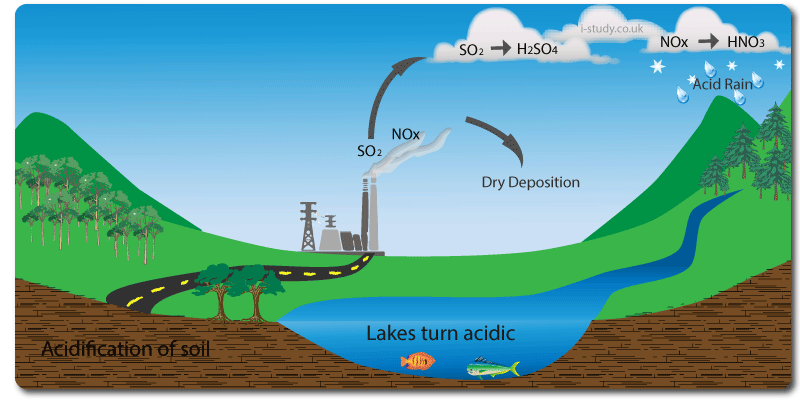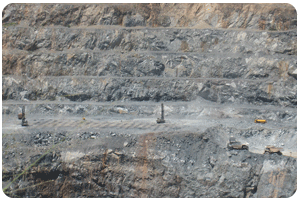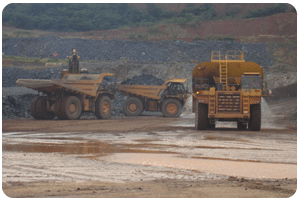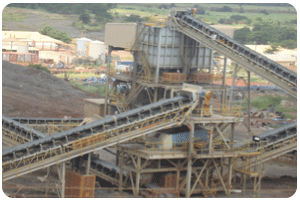Deforestation of Tropical Forests
Causes
- Logging: legal & illegal for hardwood timbers, worth $ billions each year.
- Cattle ranching: in Latin America - high rainfall & initially fertile grasses.
- Palm oil & rubber: monoculture plantations with high export values.
- Fossil fuels: oil & coal reserves exist under large areas of many rainforest regions.
- HEP: large scale hydro-electric dams have been built and more are planned in tropical regions (high rainfall rates and large rivers) which destroys vast areas of rainforest.
Effects on Biodiversity
Tropical rainforests are the home to a vast array of plants, animals and insects. They hold a significant proportion of the worlds biodiversity which is increasingly under threat due to deforestation.
As the forest is removed it initially removes the homes of the animals and insects that lived there. It has wider reaching impacts though as the nutrient cycle is broken and the original rainforest is unable to re-establish itself. The lack of vegetation leads to soil erosion. Without the trees intercepting rainfall and the mass of vegetation transpiring, the humidity levels are likely to reduce which leads to lower rainfall and potential droughts. This is very damaging for the remaining sections of the rainforest. Gaps in the food chains start to appear.
Strategies to Reduce This
Possible Causes of Climate Change
Greenhouse Effect
Theory stating that:
- Increased emissions of greenhouse gases (CO2, CFCs, methane, water vapour, ozone & nitrous oxides) from industry, power stations, cars (burning fossil fuels).
- The greenhouse layer allows solar radiation (insolation) to pass through easily but traps longer wave radiation that is emitted by the earth.
- These gases are making the greenhouse layer thicker. Trapping more of the long wave surface radiation in the atmosphere
Global Dimming
Theory stating that the increased pollution levels in the atmosphere are having a cooling effect on the climate due to increased atmospheric reflection. This is in part to the extra particles in the atmosphere but also due to the particles acting as condensation nuclei in clouds & increasing cloud reflectivity
Solar Radiation Variations
The sun has cycles of increased activity (solar maximum) & decreased activity (solar minimum) that may affect the amount of radiation reaching the Earth & therefore influence the energy balance.
Variations in the Earth’s orbit around the sun & its tilt on its axis are argued to lead to changing climate patterns over long periods of time (Milankovitch Cycles).
Current and Probable Future Impacts
- Increased melting of polar & glacial ice - leading to reduced albedo rates & more surface absorption.
- Rising sea levels due to polar ice melt & expansion of the seas as they warm.
- Increased storms/hurricanes due to warmer sea temperatures.
Possible disruption to ocean current systems as polar ice melts.
- Thawing of areas of permafrost - peat bogs are predicted to release huge amounts of methane as they thaw.
Strategies to Limit Climate Change and its Impacts
There are a plethora of strategies in place and in planning that aim to reduce the rate and impact of climate change.
- International agreements on carbon emission reductions (Kyoto Agreement)
- Carbon trading schemes.
- Increased taxes on fuels (especially aviation).
- Incentives (subsidies and grants) to develop and implement renewable energy technologies.
- Increases in efficiencies of products, cars, televisions, lightbulbs etc).
One of the main issues is that the worlds population in increasing rapidly and this is leading to increasing demands for energy - for which fossil fuels are the easiest and cheapest to use.
It is clear that for any of the strategies to be successful they will need international cooperation, and even then it will require countries to adopt several of the approaches.
Many countries are starting to establish strategies for dealing with the effects such as rising sea levels, increased drought or heavy rainfall.
London is looking to improve its Thames barrier which prevents storm surges coming up the river.
Tuvalu (a South Pacific Island) is already evacuating and rehousing some of its population in New-Zealand as high tides are inundating many areas of the low lying islands.
Acid Rain
Acid rain is the result of nitrogen oxides & sulphur dioxides are released as air pollution from transport, industry and power generation. These mix with moisture in the atmosphere and are brought back to earth in the rain as sulphuric acid & nitric acid.
The acid rain often falls a significant distance away from the source of the pollution, commonly in another country.
Acid rain has several damaging effects on ecosystems. Since it falls as rain, some is intercepted by trees and it can damage/burn their leaves/needles. Some of the acid rain infiltrates into the soil layer and is taken up by plants and trees roots which can subsequently cause the trees to suffer. The acid in the water can also increase the leaching of nutrients and minerals out of the soil leaving it degraded. Acid rain can also increase the acidity of rivers and lakes which if significant enough can kill fish and plant life in them.
There are various strategies aimed at reducing the amount of acid in rainwater. Perhaps the most significant is the drive towards reducing the burning of fossil fuels. This linked with increasing the efficiency of many domestic appliances and forms of transport is reducing the pollution being released into the atmosphere in many countries. Technologies have also been created to filter out the harmful gases in the chimneys of power stations and heavy industry.

Causes & Impacts of Urban Air Pollution
Urban air pollution is caused primarily by transport and industry. The burning of fossil fuels in transportation releases a plethora of dangerous gases. We have just seen the causes and impacts of acid rain in the environment. Acid rain also damages buildings in urban areas as it corrodes buildings. Of more concern though is the impact of air pollution on human health. Many cities with high air pollution rates are recording increases in illnesses such as asthma. The European Union has brought in regulations to control air pollution levels in cities, London has so far failed to consistently meet these regulations.
Strategies to reduce such impacts.
London Congestion Charge
This is a strategy that charges a fee for vehicles to enter the central London zone. It is aimed at reducing the amount of traffic entering central London and encouraging people to use public transport or cycle. The money generated by the scheme is used to cover the costs and the remainder invested in improing public transport. An important part of the scheme is reducing air pollution in London since it is required to meet certain standards as set by the European Union.
Water Pollution from Industrial Production and Sewage
Strategies to reduce its impact
Strategies to reduce waste sent to land fill sites
Recycling: many countries are striving to increase the level of recycling within their economies.







